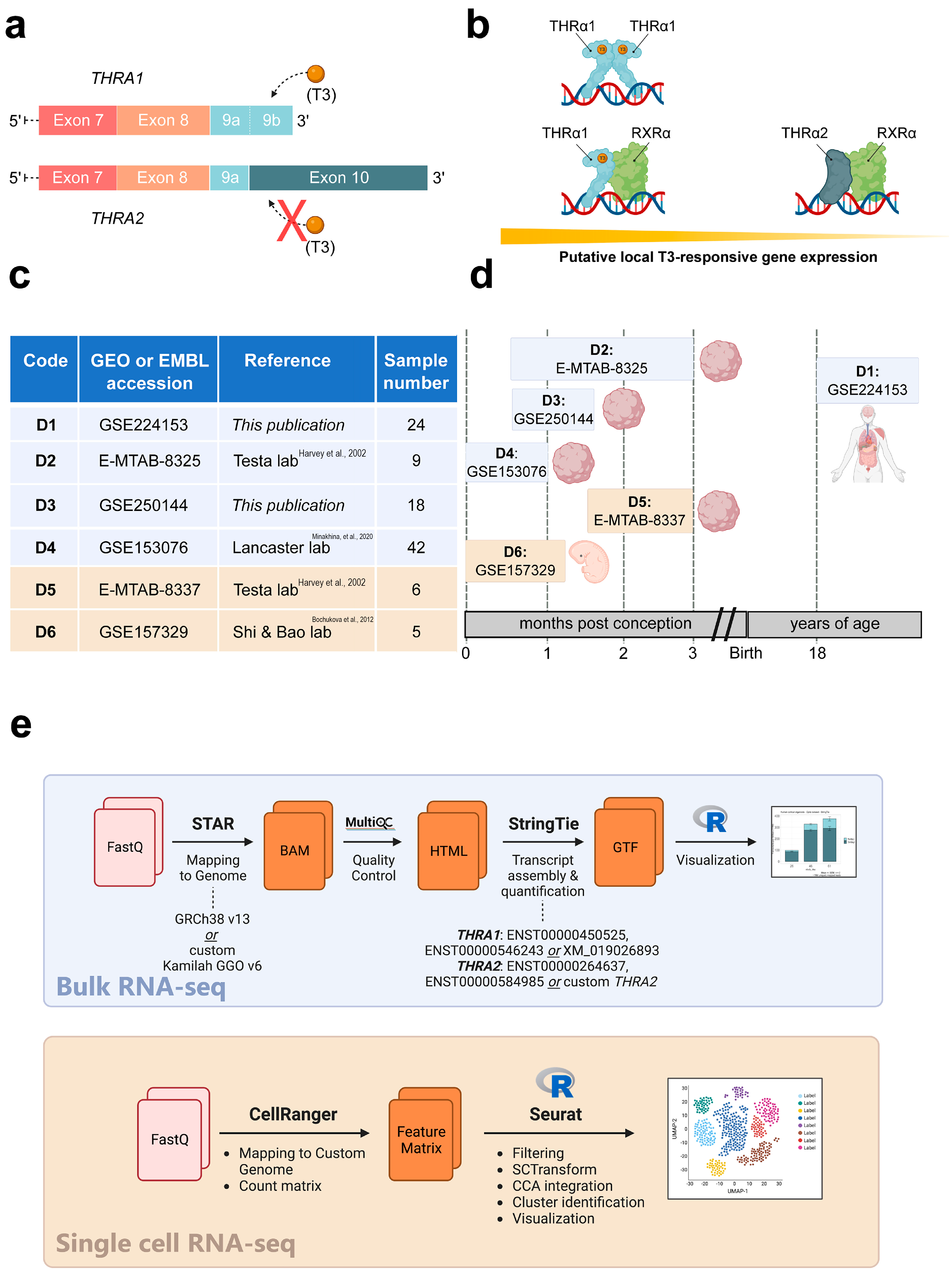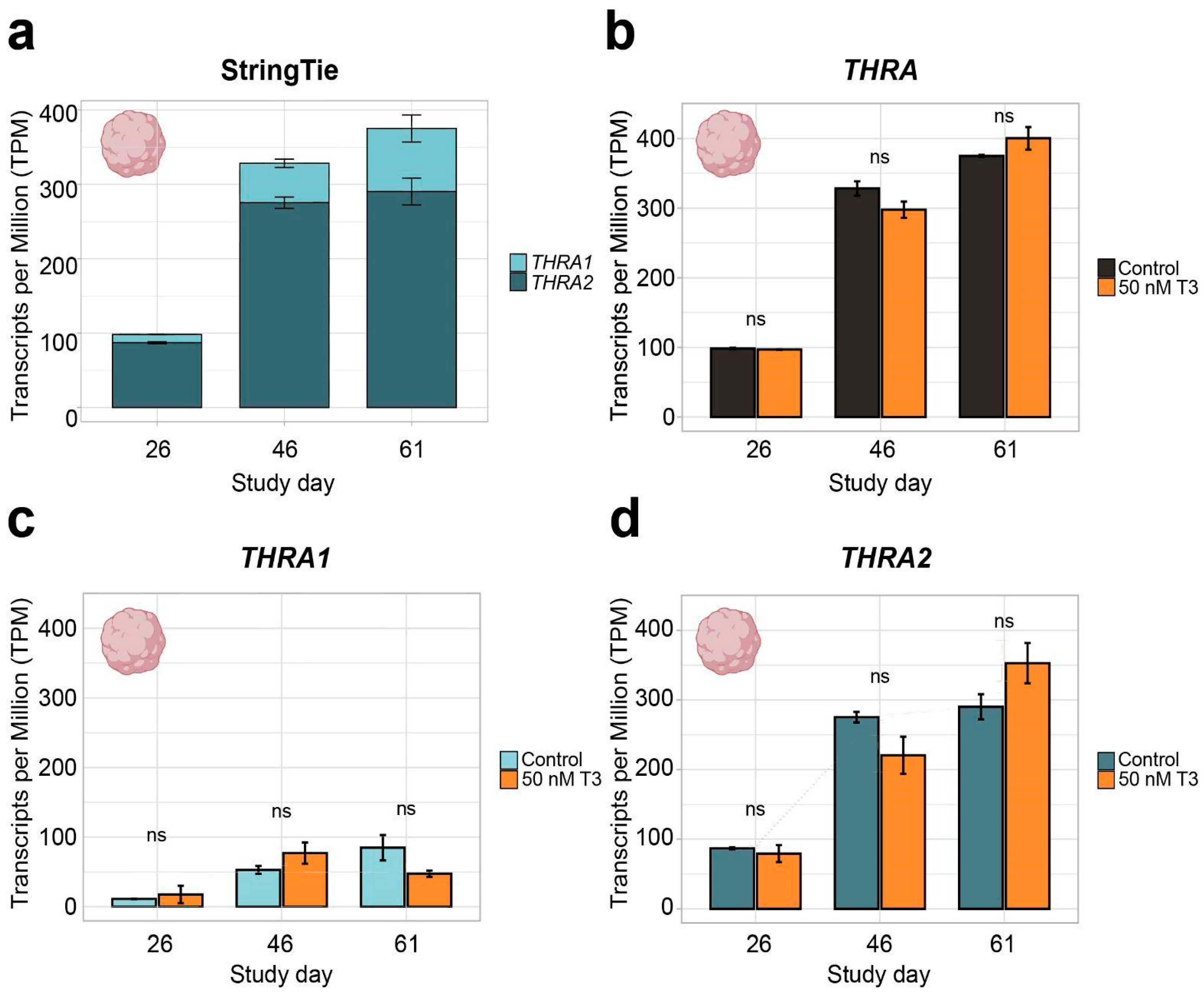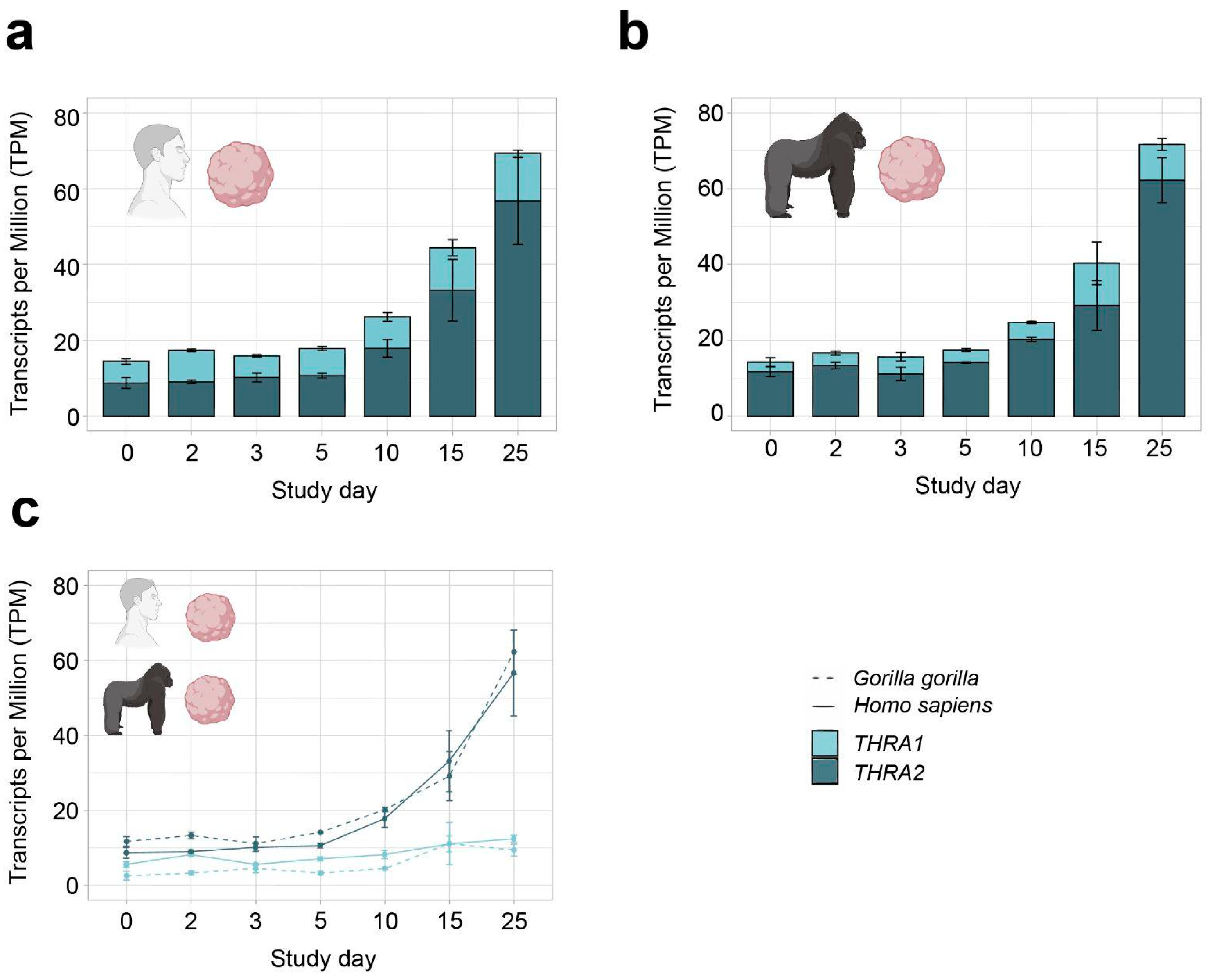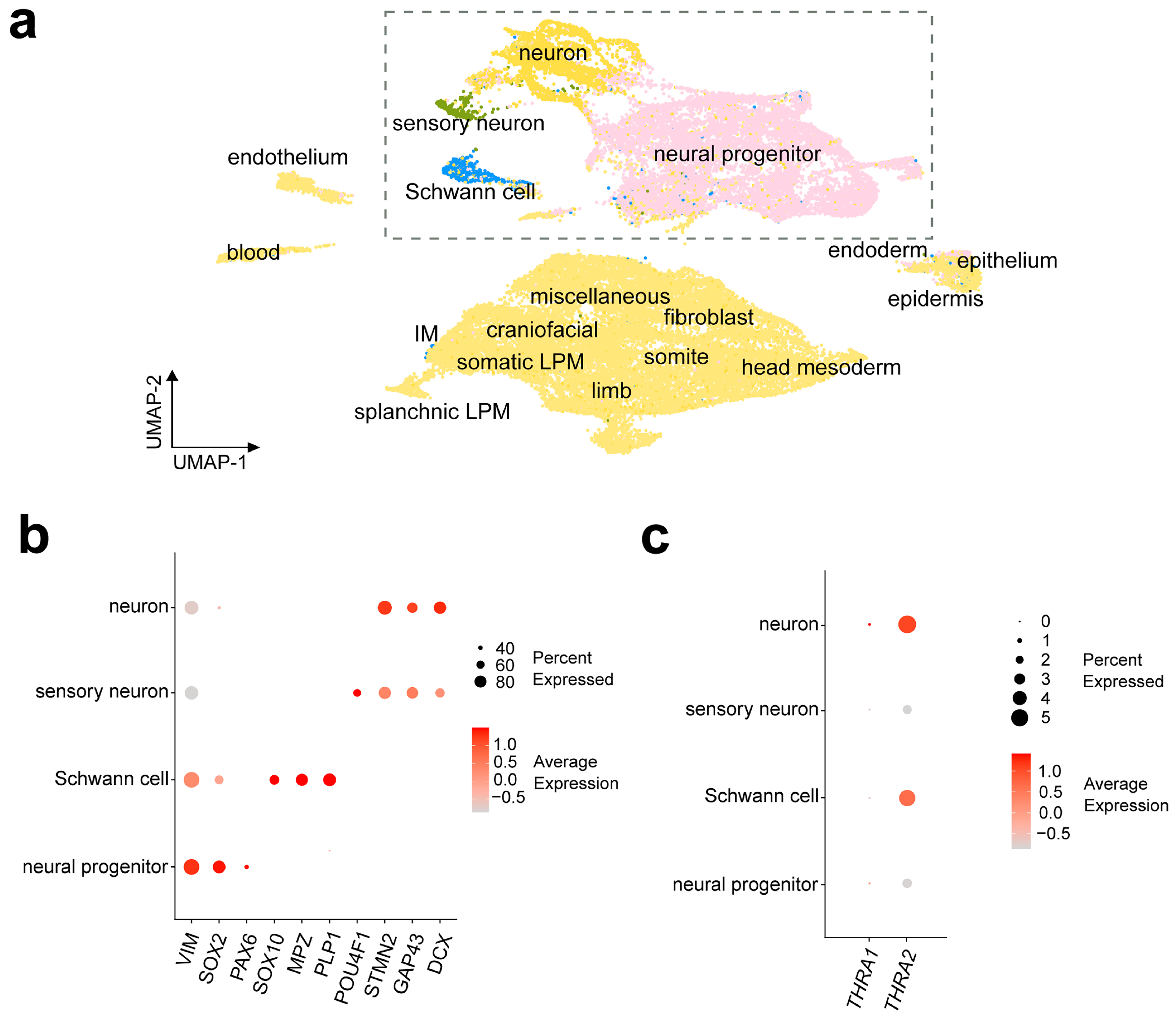RNA Sequencing Reveals a Strong Predominance of THRA Splicing Isoform 2 in the Developing and Adult Human Brain
Abstract
:1. Introduction
2. Results
2.1. Detection of THRA Isoforms in Bulk RNA-Seq Datasets
2.2. Detection of THRA Splicing Isoforms in Single-Cell RNA-Seq Datasets
3. Discussion
4. Methods
4.1. Healthy Adult Human Tissues—Dataset D1
4.2. Human Cortical Organoids—Dataset D3
4.3. Bulk RNA Sequencing—Datasets D1 and D3
4.4. Publicly Available Datasets—D2, D4, D5, and D6
4.5. Bioinformatic Analyses of Bulk RNA-Seq Datasets D1, D2, D3, and D4
4.6. Generation of a Custom Gorilla Genome Reference with the THRA2 Locus
4.7. Bioinformatic Analyses of Single-Cell RNA-Seq Datasets D5 and D6
4.8. Generation of a Customized Human Genome Reference for the Analysis of the scRNA-Seq Datasets
5. Code Availability
- STAR --runThreadN 60 \
- --readFilesCommand gunzip -c \
- --twopassMode Basic \
- --outFilterIntronMotifs RemoveNoncanonical \
- --outSAMstrandField intronMotif \
- --outSAMtype BAM Unsorted \
- --alignSoftClipAtReferenceEnds No \
- --outFilterMatchNmin 100 \
- --outSAMattrIHstart 0 \
- --alignEndsType EndToEnd
- stringtie -o ${file%.sorted.bam}.stringtie_output.gtf \
- -e \
- --rf \
- -p 60 \
- -A ${file%.sorted.bam}.gene_abund.tab \
- -C ${file%.sorted.bam}.cov_refs.gtf
Supplementary Materials
Author Contributions
Funding
Institutional Review Board Statement
Informed Consent Statement
Data Availability Statement
Conflicts of Interest
References
- Krude, H.; Kühnen, P.; Biebermann, H. Treatment of Congenital Thyroid Dysfunction: Achievements and Challenges. Best Pract. Res. Clin. Endocrinol. Metab. 2015, 29, 399–413. [Google Scholar] [CrossRef] [PubMed]
- de Escobar, G.M.; Obregón, M.J.; del Rey, F.E. Maternal Thyroid Hormones Early in Pregnancy and Fetal Brain Development. Best Pract. Res. Clin. Endocrinol. Metab. 2004, 18, 225–248. [Google Scholar] [CrossRef] [PubMed]
- Ortiga-Carvalho, T.M.; Sidhaye, A.R.; Wondisford, F.E. Thyroid Hormone Receptors and Resistance to Thyroid Hormone Disorders. Nat. Rev. Endocrinol. 2014, 10, 582–591. [Google Scholar] [CrossRef] [PubMed]
- Sandler, B.; Webb, P.; Apriletti, J.W.; Huber, B.R.; Togashi, M.; Lima, S.T.C.; Juric, S.; Nilsson, S.; Wagner, R.; Fletterick, R.J.; et al. Thyroxine-Thyroid Hormone Receptor Interactions. J. Biol. Chem. 2004, 279, 55801–55808. [Google Scholar] [CrossRef] [PubMed]
- Weinberger, C.; Thompson, C.C.; Ong, E.S.; Lebo, R.; Gruol, D.J.; Evans, R.M. The C-Erb-A Gene Encodes a Thyroid Hormone Receptor. Nature 1986, 324, 641–646. [Google Scholar] [CrossRef]
- Lazar, M.A.; Hodin, R.A.; Darling, D.S.; Chin, W.W. Identification of a Rat C-erbA Alpha-Related Protein Which Binds Deoxyribonucleic Acid but Does Not Bind Thyroid Hormone. Mol. Endocrinol. 1988, 2, 893–901. [Google Scholar] [CrossRef]
- Hermann, T.; Zhang, X.K.; Tzukerman, M.; Wills, K.N.; Graupner, G.; Pfahl, M. Regulatory Functions of a Non-Ligand-Binding Thyroid Hormone Receptor Isoform. Cell Regul. 1991, 2, 565–574. [Google Scholar] [CrossRef]
- Guissouma, H.; Becker, N.; Seugnet, I.; Demeneix, B.A. Transcriptional Repression of TRH Promoter Function by T3: Analysis by In Vivo Gene Transfer. Biochem. Cell Biol. 2000, 78, 155–163. [Google Scholar] [CrossRef]
- Harvey, C.B.; Williams, G.R. Mechanism of Thyroid Hormone Action. Thyroid 2002, 12, 441–446. [Google Scholar] [CrossRef]
- Minakhina, S.; Bansal, S.; Zhang, A.; Brotherton, M.; Janodia, R.; De Oliveira, V.; Tadepalli, S.; Wondisford, F.E. A Direct Comparison of Thyroid Hormone Receptor Protein Levels in Mice Provides Unexpected Insights into Thyroid Hormone Action. Thyroid 2020, 30, 1193–1204. [Google Scholar] [CrossRef]
- Bochukova, E.; Schoenmakers, N.; Agostini, M.; Schoenmakers, E.; Rajanayagam, O.; Keogh, J.M.; Henning, E.; Reinemund, J.; Gevers, E.; Sarri, M.; et al. A Mutation in the Thyroid Hormone Receptor Alpha Gene. N. Engl. J. Med. 2012, 366, 243–249. [Google Scholar] [CrossRef] [PubMed]
- Paisdzior, S.; Knierim, E.; Kleinau, G.; Biebermann, H.; Krude, H.; Straussberg, R.; Schuelke, M. A New Mechanism in THRA Resistance: The First Disease-Associated Variant Leading to an Increased Inhibitory Function of THRA2. Int. J. Mol. Sci. 2021, 22, 5338. [Google Scholar] [CrossRef] [PubMed]
- Moran, C.; Agostini, M.; McGowan, A.; Schoenmakers, E.; Fairall, L.; Lyons, G.; Rajanayagam, O.; Watson, L.; Offiah, A.; Barton, J.; et al. Contrasting Phenotypes in Resistance to Thyroid Hormone Alpha Correlate with Divergent Properties of Thyroid Hormone Receptor A1 Mutant Proteins. Thyroid 2017, 27, 973–982. [Google Scholar] [CrossRef]
- López-Tobón, A.; Villa, C.E.; Cheroni, C.; Trattaro, S.; Caporale, N.; Conforti, P.; Iennaco, R.; Lachgar, M.; Rigoli, M.T.; Marcó de la Cruz, B.; et al. Human Cortical Organoids Expose a Differential Function of GSK3 on Cortical Neurogenesis. Stem Cell Rep. 2019, 13, 847–861. [Google Scholar] [CrossRef]
- Benito-Kwiecinski, S.; Giandomenico, S.L.; Sutcliffe, M.; Riis, E.S.; Freire-Pritchett, P.; Kelava, I.; Wunderlich, S.; Martin, U.; Wray, G.A.; McDole, K.; et al. An Early Cell Shape Transition Drives Evolutionary Expansion of the Human Forebrain. Cell 2021, 184, 2084–2102.e19. [Google Scholar] [CrossRef]
- Krieger, C.C.; Neumann, S.; Gershengorn, M.C. TSH/IGF1 Receptor Crosstalk: Mechanism and Clinical Implications. Pharmacol. Ther. 2020, 209, 107502. [Google Scholar] [CrossRef] [PubMed]
- Incerpi, S.; Hsieh, M.-T.; Lin, H.-Y.; Cheng, G.-Y.; De Vito, P.; Fiore, A.M.; Ahmed, R.G.; Salvia, R.; Candelotti, E.; Leone, S.; et al. Thyroid Hormone Inhibition in L6 Myoblasts of IGF-I-Mediated Glucose Uptake and Proliferation: New Roles for Integrin Avβ3. Am. J. Physiol.-Cell Physiol. 2014, 307, C150–C161. [Google Scholar] [CrossRef]
- Martinez, M.E.; Hernandez, A. The Type 3 Deiodinase Is a Critical Modulator of Thyroid Hormone Sensitivity in the Fetal Brain. Front. Neurosci. 2021, 15, 703730. [Google Scholar] [CrossRef]
- Xu, Y.; Zhang, T.; Zhou, Q.; Hu, M.; Qi, Y.; Xue, Y.; Nie, Y.; Wang, L.; Bao, Z.; Shi, W. A Single-Cell Transcriptome Atlas Profiles Early Organogenesis in Human Embryos. Nat. Cell Biol. 2023, 25, 604–615. [Google Scholar] [CrossRef]
- Izumo, S.; Mahdavi, V. Thyroid Hormone Receptor Alpha Isoforms Generated by Alternative Splicing Differentially Activate Myosin HC Gene Transcription. Nature 1988, 334, 539–542. [Google Scholar] [CrossRef]
- Benbrook, D.; Pfahl, M. A Novel Thyroid Hormone Receptor Encoded by a cDNA Clone from a Human Testis Library. Science 1987, 238, 788–791. [Google Scholar] [CrossRef] [PubMed]
- Lazar, M.A.; Hodin, R.A.; Chin, W.W. Human Carboxyl-Terminal Variant of Alpha-Type c-erbA Inhibits Trans-Activation by Thyroid Hormone Receptors without Binding Thyroid Hormone. Proc. Natl. Acad. Sci. USA 1989, 86, 7771–7774. [Google Scholar] [CrossRef] [PubMed]
- Koenig, R.J.; Lazar, M.A.; Hodin, R.A.; Brent, G.A.; Larsen, P.R.; Chin, W.W.; Moore, D.D. Inhibition of Thyroid Hormone Action by a Non-Hormone Binding c-erbA Protein Generated by Alternative mRNA Splicing. Nature 1989, 337, 659–661. [Google Scholar] [CrossRef]
- Yang, Y.-Z.; Burgos-Trinidad, M.; Wu, Y.; Koenig, R.J. Thyroid Hormone Receptor Variant A2: Role of the Ninth Heptad in DNA Binding, Heterodimerization with Retinoid X Receptors, and Dominant Negative Activity. J. Biol. Chem. 1996, 271, 28235–28242. [Google Scholar] [CrossRef]
- Tagami, T.; Kopp, P.; Johnson, W.; Arseven, O.K.; Jameson, J.L. The Thyroid Hormone Receptor Variant A2 Is a Weak Antagonist Because It Is Deficient in Interactions with Nuclear Receptor Corepressors. Endocrinology 1998, 139, 2535–2544. [Google Scholar] [CrossRef]
- Nagaya, T.; Jameson, J.L. Thyroid Hormone Receptor Dimerization Is Required for Dominant Negative Inhibition by Mutations That Cause Thyroid Hormone Resistance. J. Biol. Chem. 1993, 268, 15766–15771. [Google Scholar] [CrossRef]
- Liu, R.T.; Suzuki, S.; Miyamoto, T.; Takeda, T.; Ozata, M.; DeGroot, L.J. The Dominant Negative Effect of Thyroid Hormone Receptor Splicing Variant Alpha 2 Does Not Require Binding to a Thyroid Response Element. Mol. Endocrinol. 1995, 9, 86–95. [Google Scholar] [CrossRef] [PubMed]
- Munroe, S.H.; Morales, C.H.; Duyck, T.H.; Waters, P.D. Evolution of the Antisense Overlap between Genes for Thyroid Hormone Receptor and Rev-Erbα and Characterization of an Exonic G-Rich Element That Regulates Splicing of TRα2 mRNA. PLoS ONE 2015, 10, e0137893. [Google Scholar] [CrossRef]
- Iaccarino, I. lncRNAs and MYC: An Intricate Relationship. Int. J. Mol. Sci. 2017, 18, 1497. [Google Scholar] [CrossRef]
- Hu, C.-Y.; Wu, K.-Y.; Lin, T.-Y.; Chen, C.-C. The Crosstalk of Long Non-Coding RNA and MicroRNA in Castration-Resistant and Neuroendocrine Prostate Cancer: Their Interaction and Clinical Importance. Int. J. Mol. Sci. 2022, 23, 392. [Google Scholar] [CrossRef]
- Lazar, M.A.; Hodin, R.A.; Cardona, G.; Chin, W.W. Gene Expression from the C-erbA Alpha/Rev-ErbA Alpha Genomic Locus. Potential Regulation of Alternative Splicing by Opposite Strand Transcription. J. Biol. Chem. 1990, 265, 12859–12863. [Google Scholar] [CrossRef] [PubMed]
- Katz, D.; Reginato, M.J.; Lazar, M.A. Functional Regulation of Thyroid Hormone Receptor Variant TRα2 by Phosphorylation. Mol. Cell. Biol. 1995, 15, 2341–2348. [Google Scholar] [CrossRef] [PubMed]
- Liu, Y.-Y.; Kogai, T.; Schultz, J.J.; Mody, K.; Brent, G.A. Thyroid Hormone Receptor Isoform-Specific Modification by Small Ubiquitin-like Modifier (SUMO) Modulates Thyroid Hormone-Dependent Gene Regulation. J. Biol. Chem. 2012, 287, 36499–36508. [Google Scholar] [CrossRef] [PubMed]
- Liu, Y.-Y.; Jiang, J.; Ke, S.; Milanesi, A.; Abe, K.; Gastelum, G.; Li, J.; Brent, G.A. Thyroid Hormone Receptor Alpha Sumoylation Modulates White Adipose Tissue Stores. Sci. Rep. 2021, 11, 24105. [Google Scholar] [CrossRef] [PubMed]
- Wang, X.; He, Y.; Zhang, Q.; Ren, X.; Zhang, Z. Direct Comparative Analyses of 10X Genomics Chromium and Smart-Seq2. Genom. Proteom. Bioinform. 2021, 19, 253–266. [Google Scholar] [CrossRef]
- Chomczynski, P.; Sacchi, N. Single-Step Method of RNA Isolation by Acid Guanidinium Thiocyanate-Phenol-Chloroform Extraction. Anal. Biochem. 1987, 162, 156–159. [Google Scholar] [CrossRef]
- Graffunder, A.S.; Bresser, A.A.J.; Fernandez Vallone, V.; Megges, M.; Stachelscheid, H.; Kühnen, P.; Opitz, R. Spatiotemporal Expression of Thyroid Hormone Transporter MCT8 and THRA mRNA in Human Cerebral Organoids Recapitulating First Trimester Cortex Development. Sci. Rep. 2024, 14, 9355. [Google Scholar] [CrossRef]
- Ewels, P.; Magnusson, M.; Lundin, S.; Käller, M. MultiQC: Summarize Analysis Results for Multiple Tools and Samples in a Single Report. Bioinformatics 2016, 32, 3047–3048. [Google Scholar] [CrossRef]
- Dobin, A.; Davis, C.A.; Schlesinger, F.; Drenkow, J.; Zaleski, C.; Jha, S.; Batut, P.; Chaisson, M.; Gingeras, T.R. STAR: Ultrafast Universal RNA-Seq Aligner. Bioinformatics 2013, 29, 15–21. [Google Scholar] [CrossRef]
- Li, H.; Handsaker, B.; Wysoker, A.; Fennell, T.; Ruan, J.; Homer, N.; Marth, G.; Abecasis, G.; Durbin, R. 1000 Genome Project Data Processing Subgroup The Sequence Alignment/Map Format and SAMtools. Bioinformatics 2009, 25, 2078–2079. [Google Scholar] [CrossRef]
- Wang, L.; Wang, S.; Li, W. RSeQC: Quality Control of RNA-Seq Experiments. Bioinformatics 2012, 28, 2184–2185. [Google Scholar] [CrossRef] [PubMed]
- Pertea, M.; Pertea, G.M.; Antonescu, C.M.; Chang, T.-C.; Mendell, J.T.; Salzberg, S.L. StringTie Enables Improved Reconstruction of a Transcriptome from RNA-Seq Reads. Nat. Biotechnol. 2015, 33, 290–295. [Google Scholar] [CrossRef] [PubMed]
- Liao, Y.; Smyth, G.K.; Shi, W. featureCounts: An Efficient General Purpose Program for Assigning Sequence Reads to Genomic Features. Bioinformatics 2014, 30, 923–930. [Google Scholar] [CrossRef] [PubMed]
- Zheng, G.X.Y.; Terry, J.M.; Belgrader, P.; Ryvkin, P.; Bent, Z.W.; Wilson, R.; Ziraldo, S.B.; Wheeler, T.D.; McDermott, G.P.; Zhu, J.; et al. Massively Parallel Digital Transcriptional Profiling of Single Cells. Nat. Commun. 2017, 8, 14049. [Google Scholar] [CrossRef]
- Hao, Y.; Hao, S.; Andersen-Nissen, E.; Mauck, W.M.; Zheng, S.; Butler, A.; Lee, M.J.; Wilk, A.J.; Darby, C.; Zager, M.; et al. Integrated Analysis of Multimodal Single-Cell Data. Cell 2021, 184, 3573–3587.e29. [Google Scholar] [CrossRef]







| Dataset Code | Origin | GEO or EMBL Accession Numbers | Submitted File Name | Study Day | Number of Cells before Filtering | Median Genes per Cell | Threshold % of mtDNA Genes | Threshold Number of Features [Quantile] | Number of Cells after Filtering |
|---|---|---|---|---|---|---|---|---|---|
| D5 | Testa lab | E-MTAB-8337 | 3391B_D50 | 50 | 5576 | 2566 | <5% | >200 and <9000 | 5558 |
| D5 | Testa lab | E-MTAB-8337 | kolf2c1day50 | 50 | 11,785 | 2576 | <4% | >200 and <9000 | 11,739 |
| D5 | Testa lab | E-MTAB-8337 | G1_MIF1D50 | 50 | 4602 | 1701 | <6% | >200 and <9000 | 4577 |
| D5 | Testa lab | E-MTAB-8337 | S20271_156 | 100 | 2345 | 2379 | <8% | >200 and <9000 | 2251 |
| D5 | Testa lab | E-MTAB-8337 | S20269_154 | 100 | 1389 | 1853 | <9% | >200 and <9000 | 1356 |
| D5 | Testa lab | E-MTAB-8337 | S20265_136 | 100 | 9610 | 1754 | <10% | >200 and <9000 | 9562 |
| D5 | Testa lab | E-MTAB-8337 | S20276_177 | 100 | 3188 | 1619 | <5% | >200 and <9000 | 3168 |
| D6 | Shi and Bao lab | GSE157329 | embryo1-head_trunk | CS 12 | 21,570 | 2879 | <10% | >1000 and <[90th] | 13,462 |
| D6 | Shi and Bao lab | GSE157329 | embryo2-head | CS 13–14 | 13,193 | 1546 | <10% | >1000 and <[90th] | 4386 |
| D6 | Shi and Bao lab | GSE157329 | Emb.04-head | CS 13–14 | 18,249 | 2321 | <10% | >1000 and <[90th] | 8734 |
| D6 | Shi and Bao lab | GSE157329 | Emb.05-head | CS 15–16 | 17,246 | 2894 | <10% | >1000 and <[90th] | 12,926 |
| D6 | Shi and Bao lab | GSE157329 | Emb.06-head a | CS 15–16 | 8109 | 2382 | <10% | >1000 and <[90th] | 3406 |
| D6 | Shi and Bao lab | GSE157329 | Emb.06-head b | CS 15–16 | 8357 | 1942 | <10% | >1000 and <[90th] | 3426 |
Disclaimer/Publisher’s Note: The statements, opinions and data contained in all publications are solely those of the individual author(s) and contributor(s) and not of MDPI and/or the editor(s). MDPI and/or the editor(s) disclaim responsibility for any injury to people or property resulting from any ideas, methods, instructions or products referred to in the content. |
© 2024 by the authors. Licensee MDPI, Basel, Switzerland. This article is an open access article distributed under the terms and conditions of the Creative Commons Attribution (CC BY) license (https://creativecommons.org/licenses/by/4.0/).
Share and Cite
Graceffo, E.; Opitz, R.; Megges, M.; Krude, H.; Schuelke, M. RNA Sequencing Reveals a Strong Predominance of THRA Splicing Isoform 2 in the Developing and Adult Human Brain. Int. J. Mol. Sci. 2024, 25, 9883. https://doi.org/10.3390/ijms25189883
Graceffo E, Opitz R, Megges M, Krude H, Schuelke M. RNA Sequencing Reveals a Strong Predominance of THRA Splicing Isoform 2 in the Developing and Adult Human Brain. International Journal of Molecular Sciences. 2024; 25(18):9883. https://doi.org/10.3390/ijms25189883
Chicago/Turabian StyleGraceffo, Eugenio, Robert Opitz, Matthias Megges, Heiko Krude, and Markus Schuelke. 2024. "RNA Sequencing Reveals a Strong Predominance of THRA Splicing Isoform 2 in the Developing and Adult Human Brain" International Journal of Molecular Sciences 25, no. 18: 9883. https://doi.org/10.3390/ijms25189883






